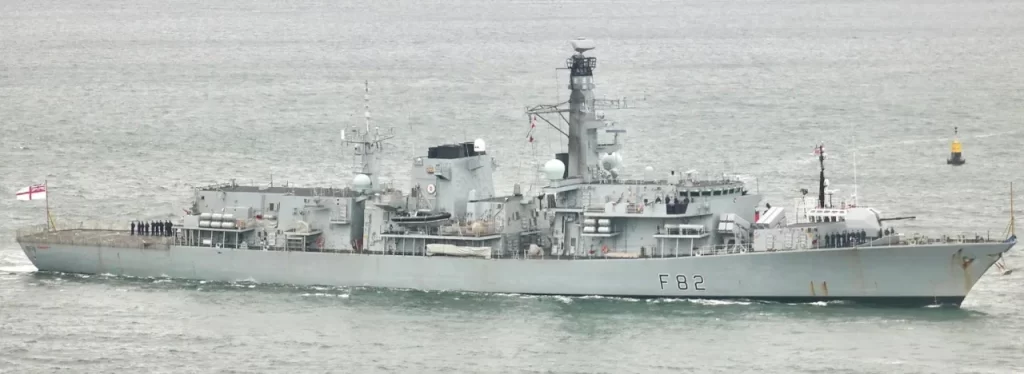The Royal Navy of the United Kingdom’s first ship was outfitted with the NSM (Naval Strike Missile) made by Kongsberg International, a Norwegian company. On December 18, 2023, the F 82 Somerset, classified as a Type 23 frigate, made its way to the British Navy base in Devonport while equipped with two four-container missile launchers designed to launch NSM missiles. Since early December, these missiles have been delivered from Norway and installed on the frigate at the HNoMS Haakonsvern naval base. They have replaced the Harpoon Block 1C missile launchers that were previously installed.
A modification was made to the Somerset frigate to carry and fire NSM missiles during a visit to Haakonsvern in January 2023. However, the missiles themselves were not delivered until just recently.
According to the Royal Navy, HMS Somerset has received the first batch of Naval Strike Missiles deployed to the Royal Navy. This means that the ship has gained Initial Operating Capability (IOC) with this weapon system, which marks the beginning of a new chapter in the surface fleet’s offensive capabilities. Reaching this milestone ensures that the fleet will continue to be able to carry out surface strikes even after the Harpoon missiles have been removed from service. Furthermore, it is also ensured that rigorous testing will be completed with live firings and ultimate operational acceptance in the year 2024.
The UK and Norwegian defence ministries signed a government-to-government agreement in November 2022 for the Royal Navy to use the NSM anti-ship/cruise missile made by the Norwegian company Kongsberg, with supplies to the UK. NSM missiles are intended to take the place of the old American Harpoon RGM-84D Block 1C anti-ship missiles, British designation GWS 60, which are expected to be completely retired by the end of 2023. However, some of them may be prolonged until 2026. The UK Ministry of Defence said that work on putting the NSM missile system on three British ships would begin soon and that the first British ship equipped with NSM would be operational in little over 12 months – a goal that has been met.

With help from Norway, British companies Babcock and BAE will integrate the missile system into dockyards in the United Kingdom.
The Royal Navy intends to replace Harpoon missiles with NSM missiles on 11 operational Royal Fleet ships, including Type 45 destroyers (Daring class) and Type 23 frigates, without specifying their type distribution. Harpoon missiles were installed on all 12 remaining operational Type 23 frigates and three of the six Type 45 destroyers (Daring, Diamond, and Duncan) as of the beginning of 2023. There will be some Type 23 frigates that will not be improved because they are going to be retired soon.
The future British Type 26 and Type 31 frigates will be outfitted with a new anti-ship and cruise missile developed as part of the UK-France-Italy FC/ASW (Future Cruise/Anti-Ship Weapon) programme. However, NSM missiles may eventually be placed on these new British frigates because the new missile is not projected to enter service until the early to mid-2030s.
The issue of replacing the Harpoon Block 1C missiles purchased in the 1980s (deliveries began in 1984) in the Royal Navy has long been debated, leading to efforts to extend Harpoon’s service life to the end of 2023. The Royal Navy launched the Interim Surface-to-Surface Guided Weapon (I-SSGW) programme in March 2019 to find a “temporary” anti-ship missile to replace Harpoon until the FC/ASW missiles enter service. NSM was considered the choice for the I-SSGW programme, but financial constraints forced its termination at the end of 2021, creating concerns that Royal Navy ships would lack anti-ship weaponry for a decade beginning in 2023. However, following the outbreak of the Ukrainian war and the demonstrable success of anti-ship missiles in it, the British Ministry of Defence secretly resumed the “urgent” acquisition project for anti-ship missiles to replace Harpoon.
The Norwegian Navy has used the NSM missile since 2012, and the US Navy and Poland have also bought it as part of coastal missile systems. As a result, the United Kingdom became the fourth recipient of NSM missiles. Furthermore, Germany, Romania, Malaysia, Canada, Australia, Spain, the Netherlands, Belgium, Latvia, and Indonesia have ordered or selected NSM missiles for purchase.
The NSMs, a fifth-generation missile with a length of about 4 metres, are designed to hit enemy ships and land targets at subsonic speeds at a distance of more than 185 km using integrated sensors and autonomous target recognition. It can use evasive movements and sea-skimming height to avoid hostile radar and defensive systems.
